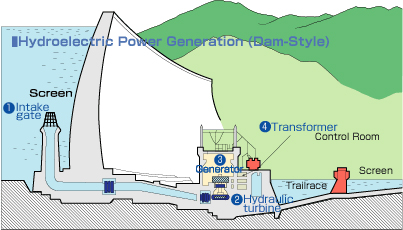
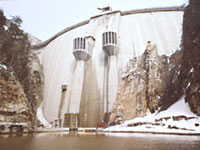
Intake gate
The water used in dam-type power plants travels from an opening that takes in water, called the intake gate, to the hydraulic turbine via steel pipes. The intake gate is located a little higher than the bottom of the water reservoir and is covered by a sturdy screen to prevent dirt, fish, driftwood, and other debris from flowing in.
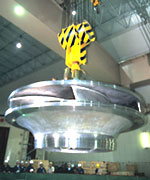
Hydraulic turbine
High-pressure water flowing swiftly through steel pipes turns the hydraulic turbine. The water volume is controlled by a speed governor so that the number of revolutions of the turbine can be maintained at a constant level. This mechanism allows for the generation of electricity at a stable frequency.
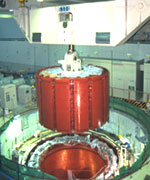
Generator
The generator is connected to the same rotation axle as the hydraulic turbine, and the rotational force of the turbine is passed on to the generator for electricity generation. The electrical output of a hydroelectric power plant is determined by the volume of water and the difference in height between the water surface of the floodway and that of the dam, according to the formula: ideal output (KW) = 9.8 (rate of gravitational acceleration) x water volume (m2 per second) x difference in height (m).
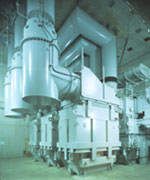
Transformer
The voltage of electricity generated by a generator is below 18,000 V. Because long-distance transmission of electricity at this voltage would result in big losses, a transformer is used to raise the voltage to 154,000 - 500,000 V before the electricity is transmitted.
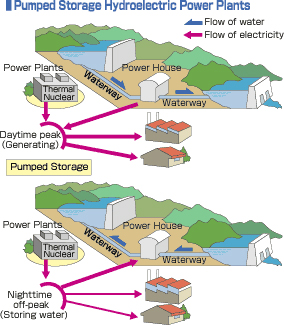
Over a one-day period, power demand fluctuates significantly between the nighttime off-peak and the daytime peak. For the purpose of generating electricity economically, it is necessary that the demand curve be flattened.
Pumped storage power plants are very useful to achieve this goal. With the power demand halved at night, TEPCO utilizes the power to pump water from the lower to the upper reservoir to create the water reserves that are discharged during the daytime to drive the turbines to generate power.
In this system the same water is cycled between the two reservoirs, thereby assuring the effective use of the area's precious water resources.
In the off-peak time, the associated nuclear and thermal power plants provide energy for pumping water from the lower reservoir.
© Tokyo Electric Power Company Holdings, Inc.